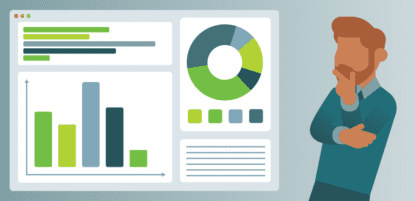It’s understandable that we want to look ahead to 2021 instead of reflecting on last year’s business challenges with COVID-19. However, as much as we may not want to think about it, 2020 contained valuable lessons learned that AP departments can apply to chart a more effective course for B2B payment operations in 2021. So, before we look ahead, let’s take a look back at 2020.
3 Key Lessons Accounts Payable Teams Learned in 2020
Here are three key lessons AP departments learned this year:
- Digitization is becoming even more important in the next normal. Manual, paper-based processes strained organizations during work from home (WFH) mandates, especially in the critical area of B2B payments. Without an automated payment solution, for example, one AP staffer had to go into the office to physically retrieve and print paper checks, deliver them to the CFO to sign, and then mail them to suppliers. As the pandemic made apparent to many organizations, paper-based processes are no longer tenable, and digitization should be a priority.
- On-time payment is critical for business continuity. When operations are running smoothly, organizations often don’t give much thought to payments, but the pandemic has shifted that thinking. Just as everyone has realized that grocery store clerks are essential workers, so too do organizations realize just how essential payments are to business operations and their overall business health.The supply chain is a delicate interdependency between buyer and supplier, and on-time payment not only helps ensure the steady receipt of goods and services, but it also impacts the financial stability of suppliers. For example, healthcare suppliers faced with severe cash flow problems during the pandemic needed fast access to cash. They increasingly turned to virtual card payments to get needed funds to manufacture the supplies in demand.
- Management is more willing than ever to digitize AP. Since the pandemic bolstered the business case for digitization, management recognizes its value now more than ever and is ready to support AP automation. Now is the time for AP departments to move ahead on these initiatives.
6 Strategies for Payments Digitization in 2021
Based on the B2B payments trends we saw and learned from in 2020, how can you be better prepared in 2021? Digitization is key to any payments program this year and beyond. Here are six strategies for establishing and implementing a successful ePayments program:
- Create a plan. It’s hard to get where you want to go without a plan. Determine key goals that you want to accomplish and the tactics to get you there. Establish a timeframe for the process, from selecting the right technology and partner to implementing the solution. If you’ve already begun digitizing your payments operations, look for ways to further your level of automation and make improvements, to increase the value you are receiving.
- Ensure the CFO is an advocate. Even if management is receptive to digitizing payments, you still have to make sure they understand the business case. In addition to key benefits – such as reducing fraud, streamlining processes, and enabling on-time payments – there are financial benefits as well, especially with virtual cards. The rebates you receive with virtual cards can offset or even exceed the cost of the underlying payments solution, giving the company cash to invest in other areas. Lastly, think about the higher value activities your team could focus on thanks to the time savings generated by automation.
- Communicate with key stakeholders. Solicit initial and ongoing feedback from all stakeholders and communicate progress. Identify the people who need to be involved in the process, and those who need to be kept in the loop, and determine the roles they need to play. Who will be instrumental in the planning and execution of the program? Which stakeholders, such as Treasury and Accounting, may not be directly involved, but will benefit from payments automation? Which business managers might want to know of a potential change in how their suppliers will be paid? What about IT, which won’t have a direct role because implementation and maintenance is easy and straight-forward, but should be kept abreast of the initiative?
- Consider the solution. It’s important to find an AP automation or integrated payables solution that offers multiple payment options in a single automated workflow so you can address changing market, supplier, and business needs without changing or disrupting your processes. As previously noted, when the market needs and conditions for healthcare suppliers suddenly shifted, a payment method that worked well before was no longer feasible.
- Find the right partner. Do your due diligence to find a partner that is right for your needs. In addition to the depth, breadth, and quality of their solutions, look for a good cultural fit with a partner that understands your preferences and values your input. This is particularly important since they will be reaching out to your suppliers on your behalf for enrollment into your ePayments program.
- Break large goals into manageable chunks and celebrate the wins. Look for the low-hanging fruit – incremental improvements that you can achieve quickly. For example, if your goal is to maximize use of virtual cards, start with suppliers that are already in your payments partner’s network of known acceptors. Once you’ve met these incremental goals, celebrate your wins. This gives you a chance to spotlight the accounts payable team and supports a culture of success.
Final Thoughts
While 2020 was a tough year, there were key B2B payments trends we learned from that you can apply to get your payment operations on the right track this year. With proper planning and a thoughtful roadmap, you can be on your way to digitizing payments – or improving the level of automation you already have in place. Make it your New Year’s resolution to ensure the business continuity of your payment operations in all business climates. You will benefit from effective and efficient operations, support good relations with your suppliers, and help reduce B2B payment fraud and costs. And the benefits go beyond that; it’s not just good for AP, but for your organization, and even your industry ecosystem, as a whole.




